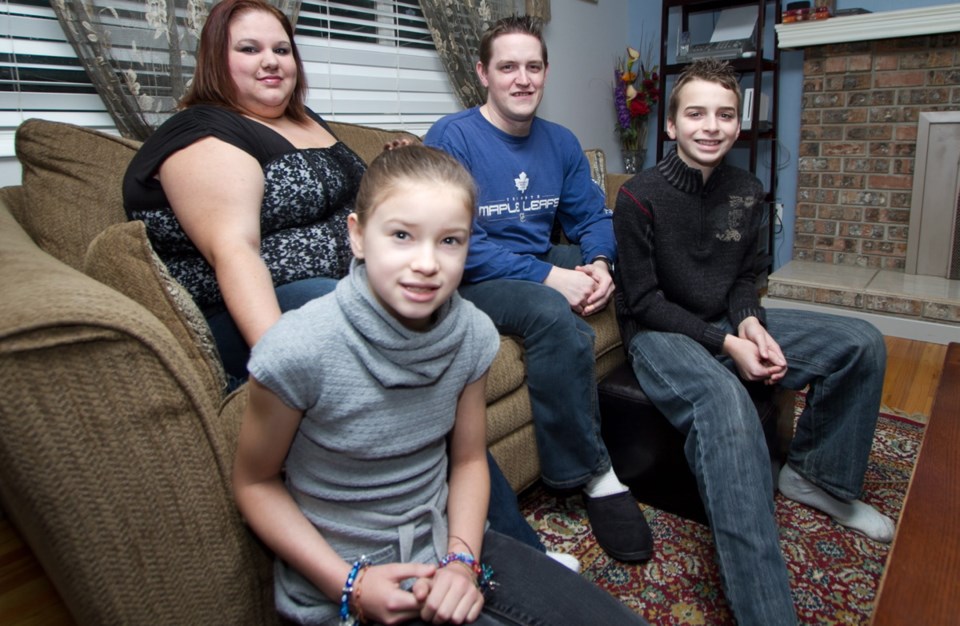Andrew Morton realized his adopted son, Devin, truly felt at home when he overheard the 10-year-old boy defending himself while being teased.
Morton said he was in the family kitchen when he heard Devin getting razzed by other kids for not knowing his real father. But the boy, who had been in 14 foster homes and one group home before he was adopted at age eight, corrected them: “My dad is in the kitchen.”
“It was a proud moment for me,” said the 30-year-old Colwood insurance broker. “You could tell he knew there was no chance of him going anywhere.”
It’s a moment that is recounted as the family continues to grow. Morton and his wife, Amandy Kelsall, have also adopted Porcia, now 10, and are in the process of adopting a third child.
Currently, 1,243 children are registered and available for adoption in B.C. — 453 are teenagers and half are aboriginal. That number is far lower than the estimated 5,200 children currently in foster homes.
However, foster families are generally regarded as temporary situations. While their placements can sometimes last many years, the long-term goal of the Ministry of Children and Family Development is to keep original families united.
Sandra Scarth, a former co-chairwoman and co-founder of the Lex Reynolds Permanency and Adoption Fund, an organization established by the provincial government to assist efforts to improve adoption successes, said more adoptive parents are always needed, especially for older children.
Scarth said B.C. has maintained fairly static adoption numbers — around 300 placements a year.
She said a plan is in the works for a publicity campaign to boost the numbers of adoptive families with a series of ads profiling “Today’s Child.” A recent smaller campaign resulted in adoptions for the majority of kids profiled.
Scarth also said she believes there are willing adoptive aboriginal families, on and off reserves, but they may not be aware of the children available for adoption. Preference is given to First Nations families adopting First Nations children, but more families are needed.
“There are aboriginal families out there and I don’t think they have any idea how many of their kids are in care,” Scarth said.
She agreed adoptive children, especially older ones, often come with emotional problems. It’s understandable, since they’ve frequently been moved from home to home.
“Think of it — every time they move, they change schools. They change their friends. They lose things,” Scarth said. “In the end, why would they trust anybody?”
As a result, adopted children are often behind in their academic work, can be socially awkward and come with acute attachment issues.
Scarth, who adopted two children, a boy and a girl, now both adults, said when her son arrived at age five, he had never heard a nursery rhyme.
“I sat down with him and treated him sometimes almost like he was a baby,” she said. “He just needed extra cuddling and reassurance that we would still be there.”
Adopted children can also face extra difficulties during adolescence.
It’s typical for those in their teens and early 20s to have identity issues, but adopted young people will have an extra layer of uncertainty as they wonder about their birth parents.
“They are going to have all these extra questions about what was back then, or what might have been,” Scarth said.
For Devin, many of those questions are answered by maintaining contact with members of his birth family, including his older brother, from whom he was separated during care and who now lives with his aunt and grandmother in Calgary.
“I have my Nana, and she’s my birth Nana and I like to go and see them,” Devin said. “Some parents don’t realize it’s better for some kids to go and see their birth families now and then.”
Devin recalls when he first went into care. He came home from a friend’s house to find “a whole bunch of cops everywhere.”
After that came a series of placements. Every time he moved, he would lose things, like his precious family photos. He would have to start all over again. “I don’t really know why I kept getting moved.”
Now he plays several sports, is in cadets, goes sailing and feels secure knowing his family isn’t going anywhere.
Devin’s mom, Amandy, 28, said initially there were severe attachment hurdles to overcome. Traumatized by moving around, Devin could barely stand to be left alone, she said.
“I couldn’t leave the house,” Kelsall said. “So we had to do baby steps.”
She remembers at first she would leave, but go no farther than the front yard, and only for 15 minutes at a time. Then she could go to the store, but again, only for 15 minutes before a reassuring phone call was made.
“We had to work with these little steps because he was terrified I wasn’t coming back,” she said.
She recalls when she and her husband were first considering adopting, they wanted a baby. But then they found themselves in a session where profiles of older children were presented and they changed their minds.
Kelsall said it’s true what is often said in adoptive circles: “Any child who comes into care will have some sort of special needs.”
But she also said adopted children can offer their own special, more mature, self-aware kind of love.
“It’s all worth it when they say something like ‘;I love you’ and ‘;I am so glad that you are my mom,’ ” Kelsall said. “I never said anything like that to my mother, but I guess if you have been through what some of these kids have seen, then it’s different.
“Devin has seen a lot in his little life and Porcia has witnessed quite a bit. But they are better now because they know that this home is now their forever home.”



